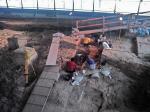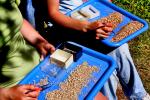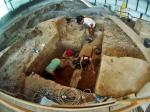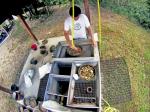Summary (English)
The site of Isernia La Pineta has made a notable contribution to knowledge of human occupation in the lower Paleolithic period in Europe. The settlement was discovered in 1978 and since then has been the object of systematic investigations. The excavations undertaken by Ferrara University in collaboration with the Ministero per i Beni e le Attività Culturali, have exposed four distinct archaeo-surfaces rich in prehistoric material.
Paleo-surface 3a, several hundred square metres of which has been explored, is of particular importance, and lies inside the pavilion inaugurated in 1999. The archaeological levels are dated to just over 650, 000 years ago, a chronology confirmed by several physical and chemical dating methods.
A large quantity of paleontological finds was recovered from surfaces 3ca and 3a. A small part of these is represented by freshwater fish vertebra, the skeletal remains of anurous amphibians (frogs and/or toads), fragments of shells from marsh turtles (_Emys orbicularis_), and bones from birds such as the wild duck (_Anas platyrhynchos_), the grebe (_Tachybaptus ruficollis_), and a passeriform. These represent the skeletal remains of the animals living in the river waters that filled the lake or on the latter’s banks and have accumulated here due to transportation or fluvio-lacustrine sedimentation.
The presence of examples of almost all the skeletal parts of the elephant (_Palaeoloxodon antiquus_), including the tusks, indicates that this proboscidean was frequently hunted. Even greater numbers of rhinoceros (_Stephanorhinus hundsheimensis_) remains were present, numbers that have led to a revision of the genus and of the European Pleistocenic species.
The artiodactyls were represented by various families: the hippopotamidae and suidae were attested by a few dental remains, attributed to the species Hippopotamus cf. antiquus and Sus scrofa.The large quantity of cervid remains represented four species: megaceros (_Megaceroides solilhacus_), deer (_Cervus elaphus cf. acoronatus_), fallow deer (_Dama dama cf. clactoniana_), and roe deer (_Capreolus sp._). Megaceroides solilhacus is not abundant among the fauna of the early middle Pleistocene period; the numerous antlers found at Isernia La Pineta have made the site the reference deposit for this species.
The predominant animal on the site is the bison (_Bison schoetensacki_), the most hunted animal, attested by numerous bony corunal processes from the horns, together with loose teeth and the remains of bones from the girdles and limbs, especially the autopodials (bones in the feet). Crania are also numerous, smashed at the base and missing the splanchnocranium (facial bones).
Like the rhinoceros, the great abundance of bison skeletal remains has led to the revision of the genus and the differentiation of the species of large bovines of the European middle-upper Pleistocene era. Another bovine, the tahr (_Hemitragus cf. bonali_) that was much smaller than the bison, was attested by only three teeth.
A leporid was also attested by a few dental remains attributed to a large rabbit (_cf. Oryctolagus_).The study of the lithic industry has identified the use of two different lithotypes, flint and limestone. It is probable that a significant functional and behavioral dichotomy, such as to justify the much wider exploitation of flint compared to limestone, was due to a difference in the availability of these two materials.
- Carlo Peretto - Università degli Studi di Ferrara - Dipartimento di Studi Umanistici
Director
Team
- Ursula Thun Hohenstein - Università di Ferrara - Dipartimento di Studi Umanistici
- Marina Cangemi
- Christophe Falguéres - Consiglio Nazionale della Ricerca Scientifica, Muséum National d’Histoire naturelle, Paris
- Jean-Jacque Bahain - Consiglio Nazionale della Ricerca Scientifica, Museum national d’Histoire Naturelle, Paris
- Qingfeng Shao - Isotopic mass spectrometer lab., College of Geography Science, Nanjing Normal University, China
- Sébastien Nomade - Laboratoire des Sciences du Climat et de l'Environnement, Gif/Yvette, France
- Tristan Garcia - Laboratoire National Henri Becquerel, Gif-sur-Yvette, France
- Benedetto Sala - Università degli Studi di Ferrara
- Giuseppe Lembo - Università di Ferrara
- Maria Chiara Turrini - Università degli Studi di Ferrara
- Carmela Vaccaro - Università degli Studi di Ferrara
- Mauro Coltorti - Università degli Studi di Siena
- Brunella Muttillo - Università di Ferrara
- Marta Arzarello - Università degli Studi di Ferrara
- Vincent Lebreton - Département de Préhistoire du Muséum national d'histoire naturelle
- Ronan Orain - Museé Nationelle d’Histoire Naturelle, Paris
Research Body
- Muséum National d’Histoire naturelle, Paris
- Università degli Studi di Ferrara






![Download [PDF]](/excavation/skins/fasti/images/results/download_sml.png)


